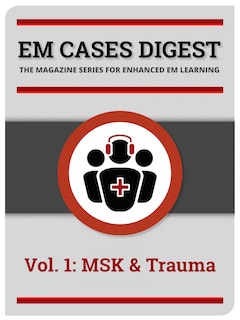In this episode on Trauma Pearls and Pitfalls, Dr. Dave MacKinnon and Dr. Mike Brzozowski discuss the latest in trauma controversies. In Part 1 they give us some key pearls and pitfalls on traumaairway management, the value of the C-spine collar, how to clear the C-spine, vascular access options in trauma, ‘Damage Control Rescuscitation’, the best resuscitation fluids to use including hypertonic saline, hemostatic drugs such as Tranexamic Acid in trauma, the vulue, or lack thereof, of Recombinant Factor 7a in trauma, and the use of Prothrombin Complex Concentrates in trauma, and many more trauma pearls and pitfalls.
Written Summary and blog post by Lucas Chartier, edited by Anton Helman January 2011
Cite this podcast as: MacKinnon, D, Brzozowski, M, Helman, A. Part 1: Trauma Pearls and Pitfalls. Emergency Medicine Cases. January, 2011. https://emergencymedicinecases.com/episode-10-part-1-trauma-pearls-and-pitfalls/. Accessed [date].
Dr. MacKinnon and Dr. Brzozowski debate questions such as: Is Ketamine safe in head injured patients? Why should we minimize the use of C-spine collars? What type of central line is best in the trauma patient? What is the evidence for a 1:1:1 ratio of RBCs:FFP:Plts in the resuscitation of the sick trauma patient? Should we be practising permissive hypotension in the multi-trauma patient? What is the evidence for the use of hypertonic saline in the trauma patient? for therapeutic hypothermia in the head-injured patient? What is the utility of blood work in the trauma patient? How useful are the ABC score and the TASH score in assessing the need for massive transfusion? Is there any role for vasopressors in trauma? Should we consider using Recombinant Factor 7a in the trauma patient? How good is the evidence for the use of Tranexamic Acid in the bleeding patient? How good is the evidence for Prothrombin Complex Concentrates like Octaplex for trauma patients taking Warfarin? and many more…..
Airway considerations in the trauma patient
- Consider Lidocaine pretreatment 3min prior to induction for RSI in head‐injured patients, although good outcome data is lacking; Fentanyl pretreatment for head‐injured patients is recommended by our experts if there is adequate time
- Etomidate – great cardiovascular profile, but no analgesic properties and results in myoclonic jerks
- Ketamine – great CV profile, and should be considered in hypotensive, head‐injured patients
- Propofol – because of the high risk of hypotension in trauma patients, it probably shouldn’t be used, even in normotensive patients
- Perform a basic neurological examination before chemical paralysis of an altered patient, with pupillary size and response, movement of all extremities, GCS and response to pain to avoid missing a spinal cord lesion and to know whether to work up a blunt vascular injury if CT head is normal
- Avoid the use of fiberoptic airway devices in the trauma patient with an airway full of blood; instead, consider a ‘bougie’
Damage control resuscitation (DRC) – 5 factors:
- Avoid hypothermia, which worsens coagulopathy, by keeping the trauma room warm, having warmed crystalloids and blankets readily available, using Bair huggers and Level1 infusers, and covering the patient as much as possible
- Permissive hypotension maintaining BP (or MAP) lower that the individual patient’s normal values in order to allow thrombus formation of injured vessels while still perfusing end‐organs; no specific number should be targeted as per our experts, but rather base the target BP on clinical factors (i.e. Is the patient mentating well? Is there adequate urine output? Is this elderly patient usually hypertensive? Is there a 3‐hour transport time?); avoid hypotension and hypoxia at all costs in headinjured patients, as it has been shown to worsen outcomes; finally, avoid over‐resuscitation, which may lead to compartment syndrome (abdominal and extremity), worsening ICP, and ARDS, pulmonary edema and prolonged ICU stay
- Ratio of 1:1:1 for pRBC:FFP:platelets – although this makes physiologic sense, our experts are not convinced by the available data given that most retrospective studies are plagued by survival bias (i.e. the longer you survive, the more FFPs you will get because it takes longer to thaw them then to just transfuse pRBC; therefore, did you survive because you got a ‘better’ ratio of products, or did you get a ‘better’ ratio because you survived); instead, our experts recommend starting FFP and platelets after 4 units of pRBCs
- Rapid and early correction of coagulopathy, which is both dilutional and secondary to the injury itself
- Damage Control Surgery, whereby the abdomen is simply packed to stop the bleeding (+/‐ splenectomy if necessary), then the patient is brought to the ICU where the patient’s parameters are improved, and then the patient is taken back to the O.R. for definitive repair of all injuries
Hemostasis in Trauma Pearls & Pitfalls
- Recombinant factor VIIa – CONTROL trial showed it to be not beneficial and possibly harmful (i.e. increased thrombo‐embolic events such as MI or DVTs) in trauma patients
- CONTROL Trial: J Trauma. 2010 Sep;69(3):489500.
- Tranexamic acid – CRASH‐2 trial, with over 20,000 trauma patients worldwide, showed a 1.5% reduction in mortality, but the population was very heterogeneous and mostly in developing countries
- CRASH‐2 Trial: Lancet. 2010 Jul 3;376(9734):2332. Epub 2010 Jun 14.
- Prothrombin complex concentrate (Octaplex) – Used, in conjunction with vitamin K, for reversal of warfarin‐induced coagulopathy; although the INR returns to normal very quickly (much faster than FFP), it is unclear whether it translates into improved clinical outcomes over FFP
Update 2018: Pre-hospital Air Medical Plasma (PAMPer) trial. A pragmatic phase 3 superiority trial involving 501 injured patients at risk of hemorrhagic shock who were given 2 units of thawed plasma during air transport to trauma centres, had decreased mortality at 24 hrs and 30 days compared to standard care resuscitation (NNT=10). Abstract
Dr. Helman, Dr. MacKinnon and Dr. Brzozowski have no conflicts of interest to declare.
Key References
Walls RM, Murphy MF. Manual of Emergency Airway Management. Lippincott Williams & Wilkins; 2008.
Cirocchi R, Abraha I, Montedori A, et al. Damage control surgery for abdominal trauma. Cochrane Database Syst Rev. 2010;(1):CD007438.
Hauser CJ, Boffard K, Dutton R, et al. Results of the CONTROL trial: efficacy and safety of recombinant activated Factor VII in the management of refractory traumatic hemorrhage. J Trauma. 2010;69(3):489-500.
Williams-johnson JA, Mcdonald AH, Strachan GG, Williams EW. Effects of tranexamic acid on death, vascular occlusive events, and blood transfusion in trauma patients with significant haemorrhage (CRASH-2) A randomised, placebo-controlled trial. West Indian Med J. 2010;59(6):612-24.
Shaz BH, et al. Increased number of coagulation products in relationship to red blood cell products transfused improves mortality in trauma patients. Transfusion. 2010 Feb;50(2):493-500.
Zehtabchi S, Nishijima D. Impact of transfusion of fresh-frozen plasma and packed red blood cells in a 1:1 ratio on survival of emergency department patients with severe trauma. Acad Emerg Med May 2009 Vol 16 No 5. pp 371-77.
Holcomb JB, et al. Increased plasma and platelet to red blood cell ratios improves outcome in 466 massively transfused civilian trauma patients. Ann Surg. 2008 Sep;248(3):447-58.
Borgman M, et al. The Ratio of Blood Products Transfused Affects Mortality in Patients Receiving Massive Transfusions at a Combat Support Hospital. The Journal of Trauma, Infection, and Critical Care 63(4) October 2007 pp 805-813.
For more on Trauma Bay Pearls & Pitfalls download free eBook EM Cases Digest Vol.1 MSK & Trauma
For more on trauma on EM Cases:
Episode 10 Part 2: Trauma Pearls and Pitfalls
Episode 39: Update in Trauma Literature
Best Case Ever 18: Anticoagulant Reversal in Trauma
Best Case Ever 20: CPR in Trauma
Best Case Ever 60 What we can learn from Prehospital Trauma Management
CritCases 3 – GSW to the Chest
Now test your knowledge with a quiz.






Leave A Comment